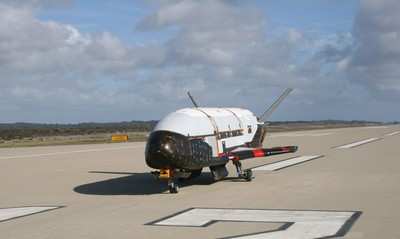Sat, Dec 04, 2010
Experimental Spacecraft Spent 220+ Days In Orbit
The U.S. Air Force's first unmanned re-entry spacecraft landed
at Vandenberg Air Force Base at 0116 PST Friday.

File Photo
The X-37B, named Orbital Test Vehicle 1 (OTV-1), conducted
on-orbit experiments for more than 220 days during its maiden
voyage. It fired its orbital maneuver engine in low-earth orbit to
perform an autonomous reentry before landing.
The X-37B is the newest and most advanced re-entry spacecraft.
Managed by the Air Force Rapid Capabilities Office (AFRCO), the
X-37B program performs risk reduction, experimentation and concept
of operations development for reusable space vehicle technologies.
The X-37B is the United States' first unmanned vehicle to return
from space and land on its own. Boeing, which built the X-37B, says
the success of this inaugural mission demonstrates that unmanned
space vehicles can be sent into orbit and safely recovered.
"Today's landing culminates a successful mission based on close
teamwork between the 30th Space Wing, Boeing and the Air Force
Rapid Capabilities Office," said Lt Col Troy Giese, X-37B program
manager from the AFRCO. "We are very pleased that the program
completed all the on-orbit objectives for the first mission."

File Photo
"We congratulate the Air Force Rapid Capabilities Office and the
30th Space Wing at Vandenberg Air Force Base on the success of this
mission," said Paul Rusnock, Boeing vice president of Experimental
Systems and program director for the X-37B. "This marks a new era
in space exploration, and we look forward to the launch of the
second vehicle in 2011. By combining the best of aircraft and
spacecraft into an affordable, responsive unmanned vehicle, Boeing
has delivered an unprecedented capability to the RCO."
OTV-1's de-orbit and landing mark the transition from the
on-orbit demonstration phase to a refurbishment phase for the
program. The Air Force is preparing to launch the next X-37B,
OTV-2, in Spring 2011 aboard an Atlas V booster.
More News
Aero Linx: Model Aeronautical Association of Australia MAAA clubs are about fun flying, camaraderie and community. For over 75 years, the MAAA has been Australia’s largest fl>[...]
Touchdown Zone Lighting Two rows of transverse light bars located symmetrically about the runway centerline normally at 100 foot intervals. The basic system extends 3,000 feet alon>[...]
“Discovery and innovation are central to our mission at Virgin Galactic. We’re excited to build on our successful record of facilitating scientific experiments in subor>[...]
How To Get A Story On Aero-TV News/Feature Programming How do I submit a story idea or lead to Aero-TV? If you would like to submit a story idea or lead, please contact Jim Campbel>[...]
Student Pilot Reported That During Rotation, “All Of A Sudden The Back Of The Plane Kicked To The Right..." Analysis: The student pilot reported that during rotation, “>[...]
 ANN's Daily Aero-Linx (05.02.24)
ANN's Daily Aero-Linx (05.02.24) ANN's Daily Aero-Term (05.02.24): Touchdown Zone Lighting
ANN's Daily Aero-Term (05.02.24): Touchdown Zone Lighting Aero-News: Quote of the Day (05.02.24)
Aero-News: Quote of the Day (05.02.24) ANN FAQ: Contributing To Aero-TV
ANN FAQ: Contributing To Aero-TV NTSB Final Report: Cirrus Design Corp SR20
NTSB Final Report: Cirrus Design Corp SR20




